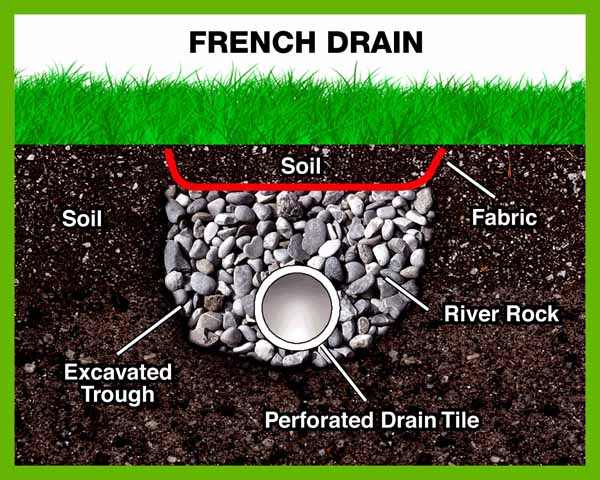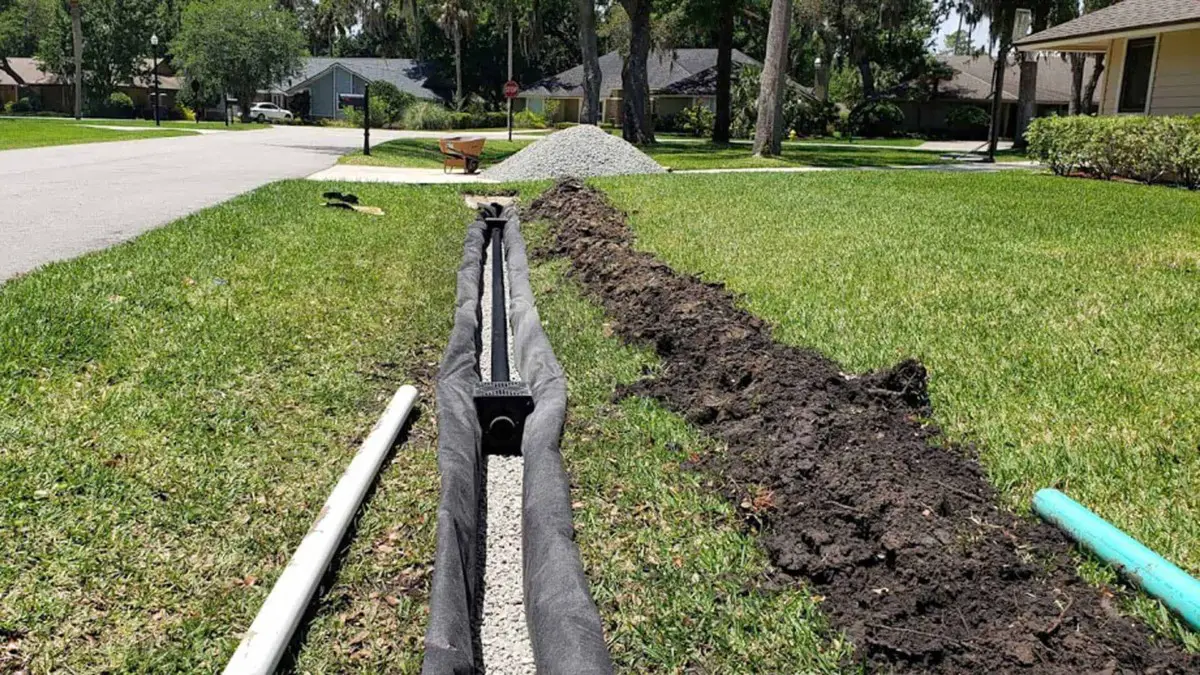The last time I installed a French Drain it was around the perimeter of my inground pool whose, one side faced a steep uphill which brought a flood of puddling, mud, and mosquitos after every rainstorm until I added a trench around 18″ deep and 25 ft long that completely dried the water-logged area and opened the once uninhabited area to grills and picnic tables. How Deep Should a French Drain Be?
About 8-24″ deep should be sufficient for many H2O diverting projects
About 18-24 ” minimum depth for foundations-this depth helps capture most of the H2O that’s an issue to protect your foundation or keep H2O out of the basement.
For a slab foundation, French Drain is about 18-24 ” below the slab.
A DIY French Drain around the outside of your house or property is an efficient way to divert water eliminating the effects that water damage can have and opening up a new space that you didn’t think you had before and maybe improving your real estate’s value.
Why Is It Called a French Drain
The name French Drain comes from a man named Henry French, who was a judge, and farmer in Concord, Massachusetts, who promoted the idea in an 1859 book about farm drainage.
Some French Drain installations are designed to empty the groundwater into your house drain system. Because a French drain is designed to work on the principle of gravity, the endpoint of the drain should be lower than your house drainage system. Other uses are:
- A low-lying area of your property
- Patio
- Pool Areas
- Basements or Sheds
- Rain Guttering Collection
French drains are used to direct surface water or problematic groundwater away from a specific area, such as a home’s foundation or somewhere the water is detrimental. French drains direct surface-level water toward the lowest point and allow it to seep through the surface-level gravel into the drain. This gravel also blocks the passage of excess debris.
A French drain is most effective if groundwater runs to space, structure, or wall when facing a hillside, if surface water enters your driveway and runs up against your home, or collects from rain gutters.
How Does a French Drain Work
 French drains provide an easy channel for water to flow through taking it away from the point where the problem location. Water can run into a gravel-filled trench, then into a perforated pipe at the bottom of the trench.
French drains provide an easy channel for water to flow through taking it away from the point where the problem location. Water can run into a gravel-filled trench, then into a perforated pipe at the bottom of the trench.
Water moves into the trench and fills up the trench from the bottom up. Enters the pipe through the holes and is diverted. Water travels freely through the pipe, which empties a safe distance from the house or area where groundwater can deteriorate property.
The trench bottom should be sloped about 1 inch for every 8 feet in the direction you want water to flow. Depending on your situation, the water can be diverted from a number of places:
A low-lying area of your property
A drainage ditch
A Dry well or Crawl Space
Fence or basement
- When water runs into a gravel-filled trench, the gravel filters large debris from entering the trench.
- PVC or Perforated pipe in the trench allows water to come into the trench and through to the intended direction, as opposed to rising to the surface. This is because, water always finds its way to the lowest points, and the slope in the pipe helps to channel water diverting away from the area you are trying to protect.
- A French drain is effective if groundwater runs to your basement, barn, or structure where the grade is moving down to a key area concerned. A French drain doesn’t require an inlet on just one end either. You can construct the drain to accept the water along its length and then disperse it underground.
- Landscaping fabric (filter fabric) acts as a filter to prevent dirt and stones from entering the pipe or clogging up the crushed stones. However, regular maintenance is still required to make sure nothing blocks the flow of water.
French Drain Diagram
A French Drain can be covered or uncovered using grass and soil or landscape rock or old-style using a gravel modified or river rock starting with larger stones on top and smaller ones as you move downward underground. A French drain pipe has small holes in the underground pipe surrounded by aggregate rock creating an underground void that can quickly drain pooling water and move it to another area
French drain depth:
The minimum depth for Foundations is typically 18 to 24 inches. This depth helps capture most of the water that’s an issue. If your goal is to protect your foundation or keep water from getting into the basement, For a slab foundation, you want the pipe below the slab.
About 8 inches to 2 feet deep should be sufficient for many water-diverting projects, with the maximum for systems being built around foundations and sub-ground living spaces, as well as the bases of retaining walls patios or problem areas, and use 10″ to 1 ft. across, will accommodate the perforated pipe.
- Dig Trench-determine proper sloping, and use a string level tied to stakes on both ends of the trench to measure the distance from a reference point on the top to the bottom of the trench. Slope 1 inch every 8 ft length
- Layer the rock for a bed to support the pipe in the trench
- Lay the PVC or Perforated Pipe
- Point the holes in the perforated pipe facing down in the trench
- Landscape Water Permeable Cloth to protect the drain from clogging with silt, drape landscape cloth across the base or footing (for a wall), and up the slope before adding the pipe and drain gravel. Near the top of the wall, fold the cloth over the top of the gravel, and top it with several inches of soil.
- Slope 1 inch for every 8 feet
- Add 3 inches of base drain stone
- Lay another 3-5 inches of stone on top
10 Steps for Waterproofing an Existing Outside Wall
What are the 10 steps for a successful solution waterproofing an existing outside Basement wall or a wall built below grade that leaks constantly when it rains .……………………… Read more
What are the types of Drains used to prevent water pooling?
General Drain types:
- Surface-removal of excess H2O from the surface
- Subsurface-removal of H2O from below the soil surface
- Channel Drains:
Used on impervious surfaces. - French Drains:
Use Gravel & Trench .…………………………………………………………………… Read more
Pipeless French Drain
The main difference between a French drain and a Trench drain is that a French drain is used for water that is underground while a trench drain diverts excess water from a surface. These Water diverters can be used anywhere on your property where puddling groundwater or rainwater can present a problem. The water collected can stay in the trench or be pumped with a sump away from the area.
This can alleviate soggy ground areas where grass won’t grow. Drying up the space can kill off mosquitoes and open up unused ground. This type of drain called filter drain won’t need to be deep just deep enough so it drains groundwater on the surface, such as removing a ponding condition from a steady rain.

How Much Gravel Do I Need for a French Drain?
Hard washed Gravel used drainage stone that is a Gray granite approximately 1/2 to 3/4 inch in size on average gravel is most commonly used in French drains, if your French drain will be 30 feet long and 1 foot wide, you would use this formula:
30ft x 1 x 0.25 = 7.5 cubic feet of Gravel per/30ft. .……………………………………………………………………………. Read more
JimGalloway Author/Editor

How to Drain Rainwater from Your Yard
